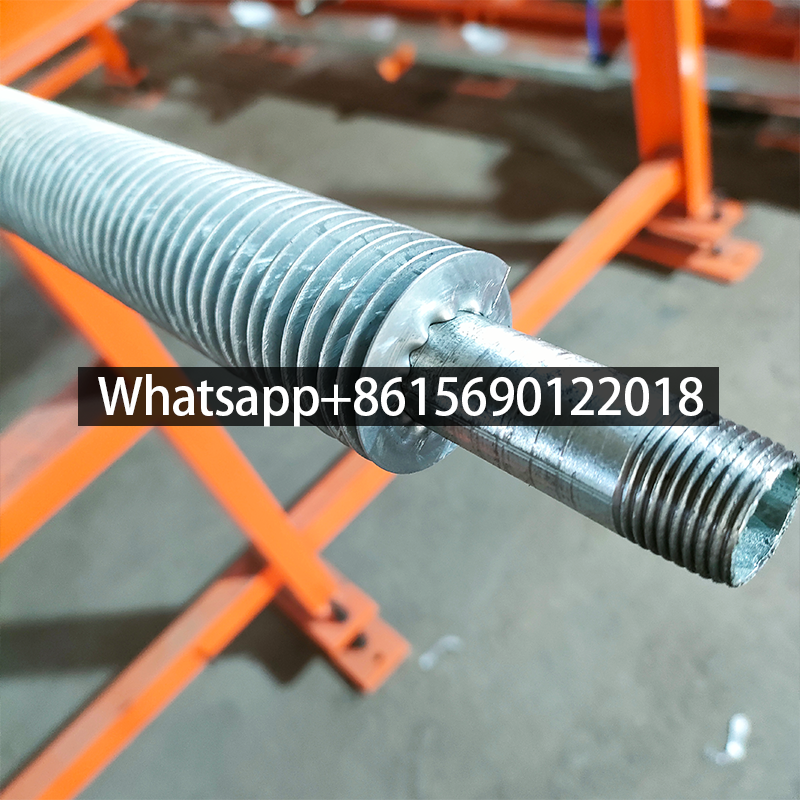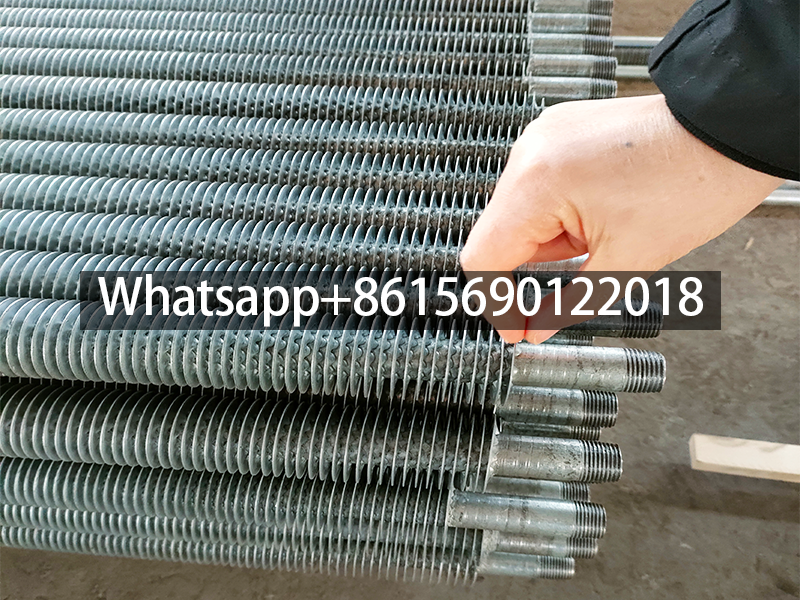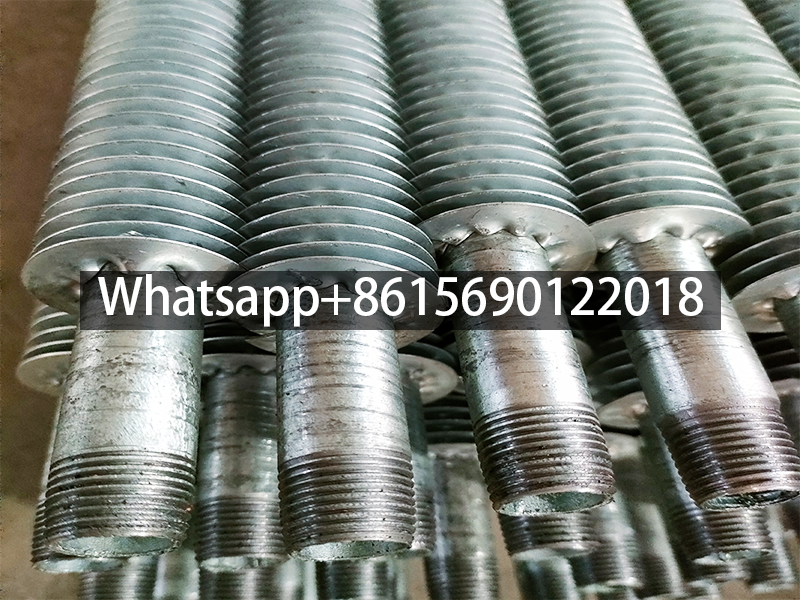What is a Threaded Finned Tube?

1. Structural Composition and Working Principle
Threaded connection finned tubes consist of two core components:
- Finned tube body: Base tubes (typically steel or copper) with radially attached fins that increase heat exchange surface area by 8-12× compared to bare pipes.
- Threaded ends: Precision-machined screw threads at tube terminals for connection1.
During operation, thermal fluid flows through the base tube, transferring heat to fins via conduction. Fins then dissipate heat to ambient media through convection.
2. Key Advantages
- Installation efficiency:
- Assembly requires only rotational tightening without welding equipment.
- Ideal for confined spaces (e.g., HVAC retrofits) and maintenance scenarios.
- Sealing reliability:
- PTFE tape fills thread gaps, preventing leaks under ≤16 bar pressure.
- Re-tightening restores seal integrity without component replacement.

3. Production Process
- Base tube fabrication:
- Cold-drawn seamless tubes (OD: 15-50mm; wall thickness: 1.5-3mm)
- Fin attachment:
- High-frequency welding ensures >95% fin-tube contact ratio.
- Spiral wrapping for uniform fin distribution (80-300 fins/meter)
- Thread machining:
- CNC threading to ISO 7/EN 10226 standards (taper: 1°47′)
- Surface treatment:
- Electropolishing or hot-dip galvanizing for corrosion resistance.
Table 1: Technical Parameters for Standard Threaded Finned Tubes
| Parameter | Specification | Application Range |
|---|---|---|
| Tube Diameter (mm) | 15-50 | HVAC/Industrial heat exchangers |
| Fin Height (mm) | 8-16 | |
| Max Pressure (bar) | 16 | Non-critical systems |
| Temp Limit (°C) | ≤200 | Low/medium thermal duty |
| Thread Standard | NPT, BSP, ISO taper | Global compatibility |
4. Applications and Limitations
- Primary use cases:
- Compact HVAC radiators (residential/commercial)
- Chemical process pre-heaters/coolers
- Design constraints:
- Unsuitable for >200°C or >16 bar environments due to thread stress risks
- Avoid corrosive media without protective coatings (e.g., epoxy lining)
5. Comparative Connection Technologies
| Feature | Threaded | Welded | Flanged78 |
|---|---|---|---|
| Installation | 10-15 min | 60+ min | 20-30 min |
| Maintenance | Tool-free | Cutting required | Bolt replacement |
| Pressure Range | ≤16 bar | Unlimited | ≤600 bar |
Threaded finned tubes deliver cost-effective modularity for low-to-medium duty thermal systems, though material selection remains critical for longevity in corrosive environments.

What is a threaded finned tube?
In the field of heat exchange equipment, threaded finned tubes have occupied a place with their unique connection method and excellent performance.
From a structural point of view, threaded finned tubes are mainly composed of finned tube body and threaded connection part.
Finned tubes are core components, and their working principle is based on heat conduction and convection. The base tube is usually made of metal, such as steel tube or copper tube, with good thermal conductivity. The fins are tightly wrapped around the surface of the base tube, greatly increasing the heat dissipation area. When the hot fluid flows inside the base tube, the heat is transferred to the fins through the tube wall, and the fins then dissipate the heat to the surrounding medium to achieve efficient heat exchange.
The threaded connection part is the key feature of this finned tube. The thread, that is, the thread, is usually processed at the end of the tube and connected by matching with the thread of other pipe fittings or equipment.
This connection method has many advantages.
The first is the convenience of installation. The threaded connection is like screwing a screw. The threaded finned tube with a thread can be rotated and connected with the matching pipe fitting. Compared with welding and other connection methods, it does not require complex welding equipment and professional welding technicians.
In some occasions where space is limited or welding operations are inconvenient, such as the installation of small indoor heat exchange equipment or partial repair and replacement of systems that have been put into use, the advantages of threaded connection are highlighted. Operators can complete installation or disassembly more easily, greatly improving work efficiency.
Threaded connection also has good sealing. During the connection process, by wrapping sealing materials such as polytetrafluoroethylene raw tape around the threads, when the threads are tightened, the raw tape is squeezed and filled in the gaps between the threads, effectively preventing the leakage of hot fluids. This sealing method is simple and reliable, and can ensure the stable operation of the heat exchange system under certain pressure and temperature conditions.

If the sealing performance is found to be reduced after long-term use, it is only necessary to re-wrap the raw tape and tighten the pipe fittings appropriately to restore good sealing, and the maintenance cost is low.
From the perspective of application range, threaded finned tubes are widely used in various heat exchange systems. In the field of HVAC, it can be used as an important component of the radiator.
In some small commercial places or residential heating systems, threaded finned tube radiators can be flexibly assembled according to the layout of the room and the heat load requirements. Its compact structure and efficient heat dissipation performance enable it to provide sufficient heat in a limited space.
In industrial heat exchange, threaded finned tubes also play an important role. For example, in some small preheaters or coolers in the chemical production process, it can be easily connected to other pipes and equipment to achieve heating or cooling of the fluid to meet the requirements of the production process.
Threaded finned tubes are not perfect
Since the threaded connection mainly relies on the friction of the thread and the sealing material to maintain the stability and sealing of the connection, loose connections or leakage may occur under some extreme conditions of high pressure and high temperature.
When designing and using threaded finned tubes, it is necessary to reasonably select pipe materials, thread specifications and sealing materials according to actual working pressure, temperature and other parameters to ensure the safety and reliability of the system.
The thread may be corroded during long-term use, especially in some corrosive media environments, which will also affect the quality and service life of its connection.
Threaded finned tube is a kind of equipment with great value in the field of heat exchange. With its unique connection method and efficient heat exchange performance, it provides a flexible and reliable solution for various heat exchange systems. Although there are some limitations, it can play its great advantages in many fields through reasonable design and maintenance.
